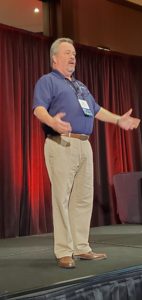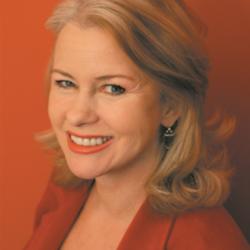
Leading With Culture
Ari Supran, CEO of Sonance kicked off Day 2 of the HTSA Fall Conference with a session called “Leading with Culture”. He discussed how Sonance had built and continues to grow a company culture that is envied in the industry. Said Ari, “Our culture is intertwined with how we talk about our business and the key to a successful culture is getting people right and getting purpose right.”
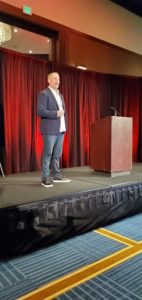
Ari Supran, CEO of Sonance ,“We all need to know why we do what we do, and the purpose is not to make money, that is an outcome, but rather, it is to make people passionate about what we do.”
Business author Patrick Lencioni was quoted and discussed several times during the Fall Conference. His book, The Five Dysfunctions of a Team, was mentioned in three presentations. Each of which focused on creating an improved workplace culture.
To help Sonance achieve an improved culture, they used two of Lencioni’s books to achieve the purpose and get the people right. From Ideal Team Player came the three key attributes of people to hire, which are Humble, Hungry, and Smart.
The ideal candidate would have each of these traits. Even if they have two of the three, it will not be enough, explained Ari:
- Humble and Smart, but not Hungry = Lovable Slacker
- Hungry and Smart, but not Humble = Skillful Politician (which are rainmakers, but can be toxic)
- Humble and Hungry, but not Smart = Accidental Mess Maker
“As vendors, we are in a partnership with our dealers to unlock value from the client. That value is not created with products, but with beliefs.”
“We have to get the people right, we have to define purpose for our team, and ensure that the team is personally invested in our culture.”
“We all need to know why we do what we do, and the purpose is not to make money, that is an outcome, but rather, it is to make people passionate about what we do.”
“Our team is personally invested in the success of our relationships. Over the last 15 years we’ve established a culture of safety. Without trust and commitment there is an avoidance of accountability. We needed authentic people we could lock ourselves in a room with until the best ideas surfaced.”
Tommapalooza
Held just prior to CEDIA EXPO in Denver and named after HTSA’s Tom Doherty, the program offered the group’s Lighting Master Class in Levels I, II, and Lighting Design and Fixture Sales Category. Delos was also there as part of the HTSA Wellness Training Program, where 15 more members were trained, bringing the total count to 40 members with Wellness Training.
Said Tom Doherty, “I figured everyone was traveling to Denver for EXPO anyway. We had targeted 30 attendees, but wound up with more than three times that: 94 members registered. HTSA members are always learning. I was primarily focused on our lighting initiatives, but there has been so much interest in Delos and the Darwin platform, we brought Wellness into the mix.”
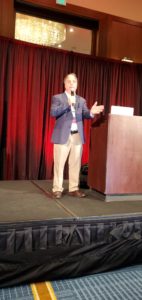
HTSA’s Tom Doherty, “For Tommapalooza we had targeted 30 attendees, but wound up with more than three times that: 94 members registered.”
Attracting Rockstar Talent
Rebecca Wagner from Accord Management Systems, a behavioral analyst and coach, discussed, “Hire to Inspire: Attracting Rockstar Talent that Lasts”. Finding and keeping top talent, as well as how to grow and develop employees. Said Rebecca, “Your people will never suddenly exceed your expectations. They will react to your training.”
Wagner then listed the “4 Distinctions of Better Hiring,” which are:
- Behavioral
- Cognitive
- Culture
- Skill
Being a behavioral analyst, Wagner urged attendees to leverage a data-driven tool to find the right people for the right seats. The tools should be simple for both the candidate and employer to use, with the assessment taking no more than six minutes. Said Rebecca, “There is a perfect behavioral fit for every role. The best way to hire top talent is to think big; think about where you want them to retire.
“Is your culture tangible? Is it obvious? Is it made of your core values? Do not post a job listing until you know what your culture is.”
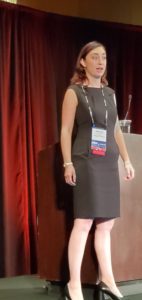
Rebecca Wagner, Accord Management Systems, “Your people will never suddenly exceed your expectations. They will react to your training.”
According to a statistical citation a bad hire is costly: it equals 30 percent of the first year of employee compensation. She said that relating to employee retention, compensation plays a role but that fitting the right person to the right job is even more critically important. “It’s the right person for the right seat. Millennials are more willing to vocalize their frustrations. They want to make an impact.”
Beware the Five Dysfunctions
Keith Esterly, HTSA’s Chief Learning Architect, summarized The Five Dysfunctions of a Team book for the integrators and vendors present. Said Keith, “You don’t get to tell your team what the company’s culture is, they get to tell you. Culture is what your people say it is. You can’t tell people you are different; you have to be different.”
The five dysfunctions are:
- Absence of Trust
- Fear of Conflict
- Lack of Commitment
- Avoidance of Accountability
- Inattention to Results
Keith discussed each of the dysfunctions, highlighting how success can be achieved when these obstacles are removed. Said Keith, “Start with trust, mine for conflict to get clarity, gain commitment, then hold people accountable and focus on results.”
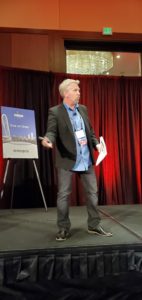
HTSA’s Keith Esterly, “Culture is what your people say it is. You can’t tell people you are different; you have to be different.”
Aging: What’s Happening Now & Opportunities for Home Tech
Scott Peifer, Founder and Principal of ChangeAgents, spoke about the aging population and technologies that are designed for that specific demographic.
Said Scott, “Two megatrends are converging. One is ‘Super Aging,’ a term describing when 20 percent of a country’s population is 65+ (10,000 people in the U.S. turn 65 each day, Peifer says); the other is ‘Exponential Technology,’ which is being used to improve daily living.”
Scott pointed out an explosion of devices and apps, currently in the market. Their usage typically falls into three main buckets of infrastructure (foundational items like lighting sensors that can help mitigate nighttime falls), senior living applications (like smart pillboxes that send notifications that can tell if a lid has opened but pills were not taken) and differentiation (innovation for care communities’ staff and residents).
Technology usage within these buckets addresses a range of areas including: entertainment, wander detection, fall detection/alert/safety, coordination communication and management, physical rehab, cognitive fitness, community connection/socialization, dementia engagement, cognitive skills, getting outside, and smart home/virtual assistant.
Regarding the last one, Scott said, “Research finds 60 percent of seniors prefer voice control over smart devices. There’s a sense that they’re losing some control over life, and voice really stood out. It gives them more control over environment, it’s easy to use, cheap, useful, smart and connected.”
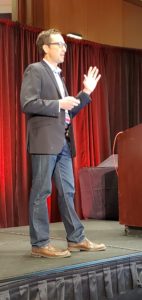
Scott Peifer, consulting group changeAGEnts, “There are two megatrends: ‘Super Aging,’ a term describing when 20 percent of a country’s population is 65+ (10,000 people in the U.S. turn 65 each day); the other is ‘Exponential Technology,’ which is being used to improve daily living.
For example, Scott discussed an AARP study on smart tracking devices that showed improved activity, sleeping, eating and overall motivation for healthy habits. From IBM, a study revealed the smart home to be an important aspect in managing the aging process.
Scott mentioned several requirements for success for integrators wanting to tap into this market, whether it’s in assisted living communities, 55+ residences, Baby Boomers in general, and both profit and non-profit groups. He says solutions need: enterprise grade Wi-Fi infrastructure, security/HIPAA compliance (preplanned, proactive user/staff setup and training), easy and clear instructions, simple user interface, integration and enterprise functionality (open APIs), reliability and settings integrity and servicing/maintenance.
Culling from various research and surveys, Scott described how the senior group had a later start to technology adoption, but now is the fastest-growing demographic in usage.
